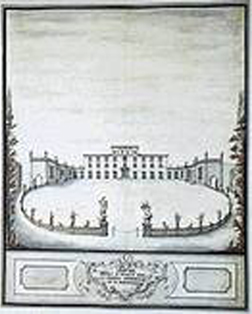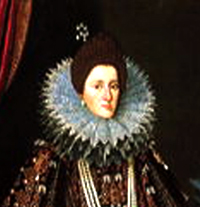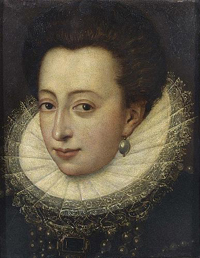What is Francesca Caccini's La Liberazione di Ruggiero About?
(This is the second of a three part essay on Francesca Caccini and La Liberzione di Ruggiero, which Magnificat will perform October 16-18. The first part, a biographical sketch of Francesca, “About Francesca“, was posted here earlier.)

Villa Poggio Imperiale in the 17th Century
On February 3, 1625, sometime in daylight, 160 gentildonne and their husbands, and an unknown number of foreign guests rode in carriages out the southeastern gate of Florence, and half a mile up a tree-lined avenue to a villa atop the nearest hill that had very recently been renovated as the personal palace of Tuscany’s regent, Archduchess Maria Maddalena d’Austria. Leaving their carriages in a grassy courtyard guarded by two squadrons of armed cavalry, the Archduchess’ guests were welcomed into the palace by a military commander, and led to bench seats in a temporary theatre built in the villa’s loggia, to hear a new commedia in musica based on a well-known plot (two sorceresses struggling over the sexual and military future of a hapless young man). The commedia was to be followed, seamlessly, by two balletti danced by members of the court, by a ballet for horses and riders in the paved courtyard, and by a reception at which the gentildonne were served by the men who rode in the final horse ballet (while their husbands watched from above). It was the first performance of Francesca Caccini’s La liberazione di Ruggiero.
So what could La Liberazione possibly have seemed to be about in 1625? First, a bit about the plot, since the story on which it’s based is not nearly as well known now as it was then.
The show opens with a prologue sung by Neptune (a figure for Medici power) and a Polish river, The Vistola, meant to praise the guest of honor in 1625, Maria Maddalena’s visiting nephew, Wladyslaw, the crown prince of Poland. Immediately afterward, the “good witch” Melissa sails up on a dolphin’s back to explain that she has come to rescue Ruggiero from the “bad witch” Alcina’s sexual spells, restoring him both to his military duty on behalf of Christian armies and to his dynastic sexual duty as the fiancée of the woman warrior Bradamante. At Melissa’s exit, Ruggiero arrives with Alcina and her retinue of singing and dancing minions. The lovers exchange perilously mis-communicated vows, and then Alcina leaves to manage government affairs while her retinue lulls Ruggiero to sleep. Dressed as his aged African teacher Atlante, Melissa returns, awakening Ruggiero with an exhortation to return to the battle for Libya. Previous victims of Alcina’s power, turned into plants by her mind-numbing spells, beg the pair to liberate them, too. After promising to return for them, Melissa leads Ruggiero away.
When Alcina and her retinue return to find him gone, a female messenger explains that Melissa has broken Alcina’s spell. Alcina confronts Ruggiero in a long scene mixed of lamentation and ire, to no avail. Enraged at her loss of power, she calls on monsters for aid. The stage is engulfed in fire, as the now monstrous Alcina rides offstage on a dragon’s back, after which creatures who had been trapped in the bodies of the island’s plants emerge to dance. One such creature pleads with Melissa to liberate the men who are plants as well as the women. They dance, and then everyone–the players and the audience–adjourn to the courtyard to watch the horse ballet, over which the triumphant Melissa presides from a centaur-drawn chariot.
My sense is that like the other comedies on which Francesca had worked La liberazione was meant to be both entertaining and serious–to give the audience the impression they were glimpsing into the ‘real’ entertainment life of the women’s court, and at the same time to engage a particular set of anxieties about that court’s relationship to public power during the regency of the 1620s.

Arch Duchess Maria Maddalena
When Grand Duke Cosimo II died in late February, 1621, the intermittent de facto regency of his mother Christine de Lorraine was replaced by a de jure regency she was to share with his widow, Archduchess Maria Maddalena d’Austria. Christine had quietly ruled Tuscany since late in 1606, first during her husband Grand Duke Ferdinando I’s final illness and then during her son’s long, losing struggle with what seems to have been several forms of tuberculosis. According to all diplomatic accounts, Christine had been Tuscany’s absolute ruler in this period, yet the same accounts report that she had shared decision-making with her son when he was up to it, and that she had systematically arranged for her daughter-in-law to be trained for what seemed like the inevitable regency of the 1620s. (One possible interpretation of La liberazione’s plot about the struggle of two women over a man, then, would be to imagine Ruggiero as the ailing Cosimo, his wife and his mother as the sorceress antagonists: but all diplomatic accounts also agree that the three worked well together.)
To be frank, there is not a lot of direct evidence in archival accounts to suggest that Tuscany’s patrician and political classes grumbled about either Christine’s de facto regency or Maddalena’s de jure one. But there is a lot of evidence showing that entertainments at court, from 1607 onward, focused on themes associated with female sovereignty, like
(1) foreign women who turned out to be queens, and who found safety in Tuscany;
(2) women who seemed to exceed the usual boundaries of female power, especially sorceresses like Alcina; and, as the de jure regency began,
3) virgin-martyrs whose choice to die rather than have either body or soul penetrated by heathens always also saved their city or their nation.
Moreover, sometime in late 1617, after one of Cosimo’s worst health crises, a court functionary named Cristoforo Bronzini began work on what would become an encyclopedic, 25-volume manuscript in dialogue form entitled Della dignita e nobilta delle donne, of which 8 volumes were published between 1622 and 1632. Combining proto-feminist arguments justifying women’s right and ability to rule the state with hundreds of biographies of women worthies (including the one of Francesca Caccini in the first part of this essay), Bronzini’s project was clearly intended to normalize the regency, and to normalize some of Maddalena’s peculiar ways–notably her passion for and her excellence at shooting, hunting, and horseback riding. Maddalena meant to distinguish herself from her rather genteel mother-in-law, Christine de Lorraine, in other ways as well. Unlike the Medici-descended Christine, who had centered her court at one of the Medici country villas already associated with the family’s women and children, Maddalena acquired a palace just outside the city walls as the center of her court.
Dedicated publicly in 1624 to her own Habsburg heritage, and to the leisure of future Tuscan princesses, the Villa Imperiale had once been the palace of a 16th-century Medici princess, the only daughter of the dynasty’s founder, who had been murdered there by her husband, for her outspoken political opinions, her unashamed musical and poetic performances, and her open adultery. Maddalena presumably meant to rehabilitate the memory of this gifted and transgressive woman when she ordered her palace rehabilitated, and adorned with two elaborate gardens (of roses and citrus), and 2 sets of frescoes (of historically important queens and of Biblical heroines): the palace reconciled the memory of the most intellectually ambitious and sexually dangerous Medici woman to the unquestionable virtue of the exceptional, excessive women painted on the villa’s ceilings. The site where La liberazione was first performed, Maddalena’s Villa Imperiale was simultaneously the private seat of the Tuscan regency and the newly constituted center of the women’s court.

Grand Duchess Christine of Lorraine
Maddalena and her mother-in-law Christine had, in effect, long shared rule over the institution known as the “women’s court”. In the ducal and princely classes of early modern Italy, it was common practice for the wife of a ruler to live principally at a suburban villa rather than in the family’s urban palace, visited by her husband as he pleased. These wives ruled absolutely over extended households that consisted of them, their children, and any nieces/nephews or cousins who might visit, along with the elite young women who served them as dame and donne, servants of all kinds and all sexes, and male secretaries detailed from the central office in Florence. A well-known feature of such courts (one that seems (to me) inexplicably lost in standard histories) is that the women at the top of their hierarchies–the Grand Duchesses and Archduchesses– managed the marriages of their dame, donne, female relatives below princess rank, and servants of both sexes.
When I say they managed these marriages, I mean they superintended the negotiations over dowries, the payment of dowries, and the restitution of dowries if a marriage failed for whatever reason; they advocated for women whose husbands turned either physically or fiscally abusive, sometimes ordering the physical rescue of such women and the imprisonment of the guilty men; they were known to force women and men alike to marry for the sake of preserving a family’s patrimony; and they routinely forced widows under 40 into remarriages that would channel their sexuality and thus preserve their reputations for chastity. Because the women’s court over which Christine and Maddalena presided were communities in which women managed ‘the traffic in women’ to preserve a heteronormative gender order, I have described this situation as female patriarchy. Whatever one might call it, however, it was a situation that, I speculate, encouraged the formation of strong mutual allegiances among elite women, strong loyalty toward the women at the top of the hierarchy, and a shared understanding that heterosexuality was compulsory but heterosociality was not, and it was not at the core of a woman’s loyalties to her ‘tribe’. It was in service to this kind of community that Francesca Caccini passed most of her working life, providing entertainments for the women and children whose communal relations were forged by a ‘traffic in women among women’ and, as a letter by Grand Duchess Christine would eventually argue, providing through her teaching and coaching of women’s and children’s musical performances a model of female authority that was obviously legitimated by competence and mastery.
However commonplace the traffic in women among other women might have been, in a time of multi-generational regency like the one Tuscany knew from 1606 to 1636, the potential for women’s court *ruled by foreigners* to be an alternative source of power seems likely to have been frightening to the patrician class of men. For these men knew that the political (and economic) future of Tuscany depended on decisions made in such an environment, even if they were made by Medici boys being groomed for leadership there, or by ministers (like first and second secretaries Curtio Picchena and Andrea Cioli) whose rise to political power was directly the result of the relationships they had cultivated in this community of women. For men who spent too much time with women–even is as their heterosexual lovers–were understood to become gradually effeminate, to sink to the level of the pleasure-loving, singing-and-dancing, reason-abjuring level of the not-quite-human creatures among whom they lived.
To become, that is, like the plants in Alcina’s garden.
To follow “Part 3: La Liberazione di Ruggiero and the Culture of Women”.